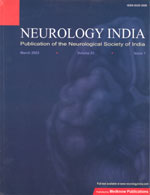
|
Neurology India
Medknow Publications on behalf of the Neurological Society of India
ISSN: 0028-3886
EISSN: 0028-3886
Vol. 58, No. 2, 2010, pp. 242-247
|
 Bioline Code: ni10063
Bioline Code: ni10063
Full paper language: English
Document type: Research Article
Document available free of charge
|
|
|
Neurology India, Vol. 58, No. 2, 2010, pp. 242-247
| en |
Microsurgical subtemporal approach to aneurysms on the P 2 segment of the posterior cerebral artery
Zhitao, Jing; Yibao, Wang; Anhua, Wu; Shaowu, Ou; Yunchao, Ban; Renyi, Zhou & Yunjie, Wang
Abstract
Background: Aneurysms arising from the P 2 segment of the posterior cerebral artery (PCA) are rare, accounting for less than 1% of all intracranial aneurysms. To date, few studies concerning the management of P 2 segment aneurysms have been reported.
Objective: To review the microsurgical techniques and clinical outcomes of microsurgical treatment by different approaches in patients with aneurysms on the P 2 segment of the PCA.
Materials and Methods: Forty-two patients with P2 segment aneurysms had microsurgical treatment by subtemporal approach. All the patients had drainage of cerebrospinal fluid for decompression, and indocyanine green (ICG) angiography was used in 20 patients to assess the effect of clipping.
Results: Of the 42 patients, 16 were operated by combined pterional-subtemporal approach. In 40 patients aneurysms were successfully treated by clipping the P 2 aneurysmal neck while preserving the parent artery. Two patients with giant aneurysms were treated using surgical trapping. Postoperatively, 41 patients had a good recovery. One patient after aneurysm trapping had ischemic infarction in the PCA tertiary and presented with hemiparesis and homonymous hemianopia. However, this patient recovered after three weeks of treatment.
Conclusion: Subtemporal approach is the most appropriate approach to clip the aneurysms of the P 2 segment. It allows the neurosurgeon to operate on the aneurysms while preserving the patency of the parent artery. Gaint P 2 segment aneurysms can safely be treated by rapping of the aneurysm by combined subtemporal or pterional-subtemporal approach in experienced hands.ICG angiography will be an important tool in monitoring for the presence of residual aneurysm or perforating artery occlusion during aneurysm clipping. Preoperative lumbar drainage of cerebrospinal fluid may help to avoid temporal lobe damage.
Keywords
Indocyanine green, posterior cerebral artery, P 2 segment aneurysm, subtemporal approach
|
| |
© Copyright 2010 Neurology India.
Alternative site location: http://www.neurologyindia.com
|
|
